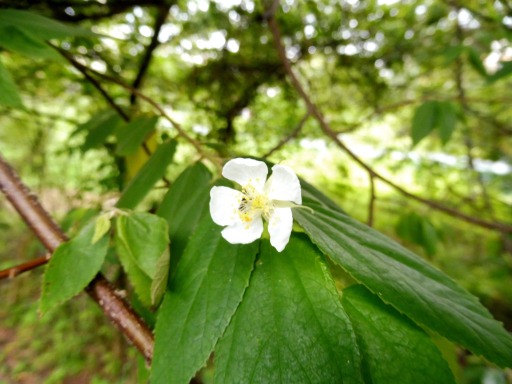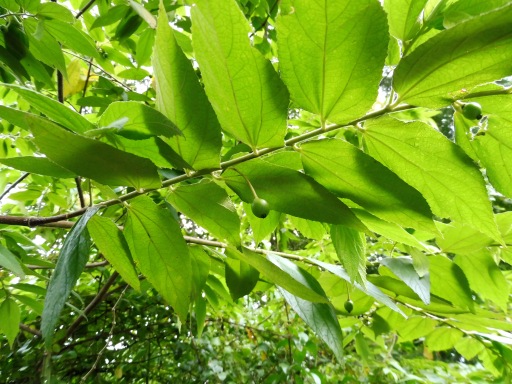It was raining, and my usual route through the buildings would keep me dry. So, naturally, up the open slope I went, managing to nearly poke someone in the eye when I stopped suddenly at a buah cheri tree (Muntingia calabura) I’d never noticed before. Known more commonly elsewhere as the Jamaican cherry or Panama berry, it’s indigenous to southern Mexico, Central America, tropical South America, the Greater Antilles, St. Vincent and Trinidad. As to why it’s called the Jamaica cherry, this is likely because the type specimen was collected there. It was introduced in the Philippines in the late 19th century and has spread across Southeast Asia since, becoming naturalised. Interestingly, it’s the only member of the species in its genus.

Jamaican cherry flower, sheltering an ant
A long time ago it was a very popular tree in Singapore- the berries are sweet, sticky, and much loved by children with a sweet tooth, plus it provides a nice amount of shade. As expected, the fruits are equally popular with birds, bats, and squirrels. This unfortunately also meant that the birds would be rather active at both ends of their digestive tracts, and it’s since been phased out in urban areas. In Brazil, they’re often planted along rivers, where fish eat the dropped berries and can be caught. In India, it’s grown to attract birds.
Although I can see why people might not like the noise and droppings it brings, I personally find this to be quite a pity- the entire tree is quite useful, and in fact is pleasant to the eye too. Besides the fruits, flowers can be can be steeped and the infusion taken as a remedy for headaches and colds. A tea can be made from the leaves- reportedly antiseptic and good against abdominal cramps, ropes and baskets from the bark, and paper from the wood, besides the usual carpentry and kindling. It is of course cultivated in some countries, where berries can be harvested by simply shaking the tree.

Jamaican cherry fruits
Seeds of the plant germinate quickly and the tree flowers and produces fruits in just two years, flowering and fruiting year round. Pretty amazingly, it tolerates a wide range of soil conditions, although it prefers a pH of 5.5 to 6.5. It grows best at 22 to 36 degrees (Celsius), is drought resistant, and can tolerate air pollution in cities. The only weakness is that it requires some shelter, since the wide branches can break when subjected to winds. Still, its resilience makes it perfect for restoration projects.
This tree still has on it a number of flowers, which are reportedly quite malodorous, but which I didn’t sniff. Oh, and a whole lot of green fruits of varying sizes. I shall update this when they ripen, which means that I’ll need to walk up the slope again sometime. Now I just need to wait for it to rain in the morning…
References
- https://florafaunaweb.nparks.gov.sg/special-pages/plant-detail.aspx?id=3036
- http://tropical.theferns.info/viewtropical.php?id=Muntingia+calabura
- https://en.wikipedia.org/wiki/Muntingia
- http://www.besgroup.org/2011/11/14/planting-for-birds-muntingia-calabura/
- https://hort.purdue.edu/newcrop/morton/jamaica_cherry.html










hi, may i know where u spotted this? 🙂
LikeLike
Hi! I saw this in Singapore, sort-of forested area in the West 🙂
LikeLike